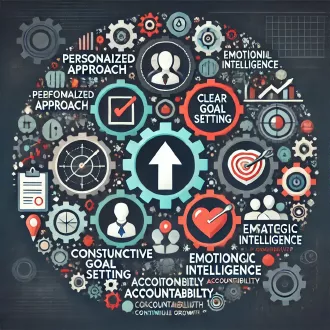Transcription Characteristics that distinguish a leadership coach
The world of work is constantly evolving, and in this context, the role of the leader takes on significant importance. In this regard, a number of key characteristics have been identified that make a coach exceptionally effective in both areas.
Ability to welcome the opinions and ideas of others.
The best coaches value and encourage open communication, allowing coachees to feel valued and appreciated by sharing their perspectives.
What employee wouldn't like good communication with their superiors - there is no better way to involve them in actions and engage them in the goals of the organization than to keep them informed, ask for their opinions and listen to their concerns. Reaffirm that their collaboration is important and that they are an active part of the team.
Understanding individual needs.
This allows them to offer specific and relevant guidance for growth. Discovering exactly what they need to improve their current performance and what they need to reach the next level.
The coach must assess the coachee's limiting deficiencies and above all their strengths in order to work on improving their performance.
Goal-oriented approach.
This approach involves focusing on results and goals, and motivating the coachees to work together to achieve them.
Determine what they want/need and create a plan to achieve it. At this point it is important to establish the role you play within the organization and how your actions and performance affect the rest of the team. The plan does not need to be complicated, it just needs to be goal oriented.
Ability to collaborate with coachees.
Participate in idea generation, solution identification and problem solving. This collaboration fosters shared responsibility and enables coachees to develop critical thinking and decision-making skills.
By tracking a given situation in real time, you can determine how the coachee deals with obstacles, the strategies they employ and the solutions they are able to find. Together you can draw lessons learned and evaluate the outcome.
Be a source of encouragement and support.
Good coaches inspire confidence and self-esteem in individuals by caring about them and their well-being, encouraging them to believe in their own abilities and overcome challenges.
In addition, they offer valuable guidance and advice, adapting to the individual needs of each coachee.
Be respectful.
Respectful coaches avoid making assumptions and listen carefully to coachees, creating a supportive and trusting environment.
They respect the coachees' privacy and treat them as unique individuals, tailoring their approach to their needs and preferences. And of course they avoid drowning the coachee with advice and suggestions without first giving them space to work it out for themselves.
Leadership experience.
This experience gives the coach a deep understanding of the challenges and opportunities leaders face in their role, enabling them to offer relevant and practical guidance.
Clear and effective communication.
Listening a lot and talking as much as necessary but making sure the message gets across clearly. Clear communication is essential for a leadership coach. He or she must be able to convey complex concepts in an accessible way and motivate coachees to take concrete steps toward their goals.
But the main characteristic that distinguishes a leadership coach is his or her desire to make a difference in the lives of others. All other qualities are derived from this intrinsic disposition. The desire to positively impact and improve the lives of coachees is a coach's most valuable asset and drives him or her to excellence. Without this motivation, all other qualities are ineffective.
characteristics




